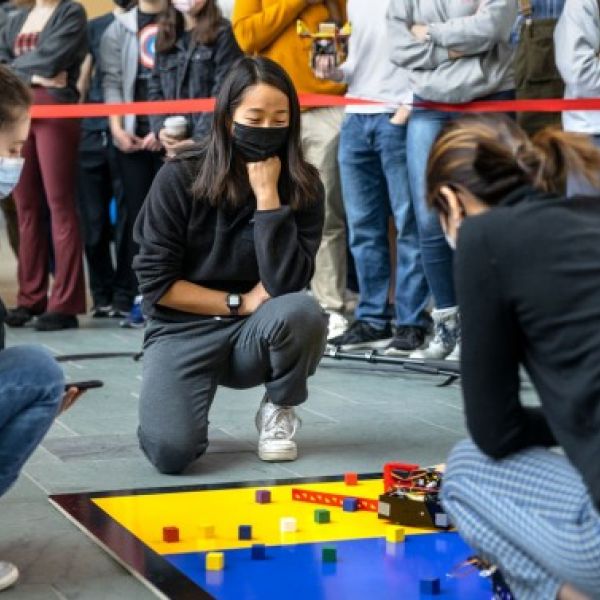By Eric Laine for the Cornell Chronicle
A bit of history was made in the annual robotics competition, Dec. 7 in the atrium of Duffield Hall, where a robot created by Cornell students defeated the corporate sponsor’s robot in a head-to-head block-gathering challenge.
The 150 student participants, who were completing their final projects in the Mechatronics course taught by Benjamin Finio, lecturer in the Sibley School of Mechanical and Aerospace Engineering, formed teams of three to build autonomous robots designed to compete in a game of strategy and skill. The challenge: to move 1-inch-square wooden blocks onto their opponent’s half of a 4-foot-square, two-colored field. Each robot starts with 10 blocks on its half; each game lasts 60 seconds.
The winning student team earns the right to face a robot brought by longtime corporate sponsor ASML, the Dutch chip-machine manufacturer. The day was won by master’s students Yihan Zhu, Zhiyu Wang and Kyung-Rak Jang, whose robot, dubbed Googly Eye, not only bested its Cornell competition, but took down the ASML team’s entry, the Blue Owl.
It was only the second time since ASML started sponsoring and participating in the Mechatronics competition that the Cornell champion defeated the ASML robot.
“We didn’t hard-code too much,” Wang said, describing the team’s strategy. “Instead, we let the robot react to the sensor feedback. Thus, all we can say is that we made our robot smart enough, and it did a great job on its own.”
The robots’ sensors detect the colors, which is how they know which side of the board they are on, and how they avoid driving off the edge. Many of the robots deployed arms or wings to gather blocks.
Finio said his goal is to give students a broader understanding of what it means to be a mechanical engineer.
“This is about synthesizing a lot of prerequisites into a more complex system,” Finio said. “These students have all taken a programming class, they’ve taken a physics class, they’re starting to learn about circuits and the math behind how circuits work, and they’ve taken a mechanical design class. You have to put all that together to do this project.”
Eleanor Anderson-Zych ’23, who participated in the competition, said the project demands interdisciplinary skills.
“Learning to work in a team, coordinating so many different parts – there’s code, there’s circuits, there’s mechanical design,” she said. “Integrating all of it was a really big learning objective.”
Anderson-Zych and teammates Raphael Fortuna ’23 and Ragini Balachandran ’23 built a robot with long red arms, named Sebastian for its resemblance to Disney’s animated crab.
“In mechanical engineering, you think it’s just design, but there’s a lot more to it,” Balachandran said. “In this competition, you learn about strategy, you learn about time management and you end up programming. And those are things you don’t normally get exposure to all at the same time.”
Ken Bogursky ‘96, director of mechanical development for ASML, brought to the event a team of engineers who spent time connecting with students, discussing design and strategy, and keeping an eye out for potential future colleagues.
“Cornell students are the best of the best,” Bogursky said. “Our sponsorship of the Mechatronics class and this competition gives us an opportunity to challenge ourselves, to partner with colleagues and expand our network, and do something fun.”
Adam Kane, ASML’s director of software and electrical engineering, said the event creates opportunities to demonstrate to students an often-overlooked aspect of engineering.
“Creativity is really what wins this challenge,” he said. “And creativity, at the end of the day, is key to being a really good engineer, not just knowing the laws of physics.”
Alison Candy ’23 said her team’s robot was named Moni – “which is short for the Monstrosity because it was giving us some issues earlier,” said Candy, who described frustrating evenings working on the project, which ultimately brought her team some early-round success.
“I think one of the big things we learned was that you have to break things down into smaller steps and goals,” said Maia Raynor ’23. “Initially we had a very complex strategy for what we wanted to do today. [But] by the time we got here, we’re going for something much simpler.”
Eric Laine is communications specialist for the College of Engineering.



